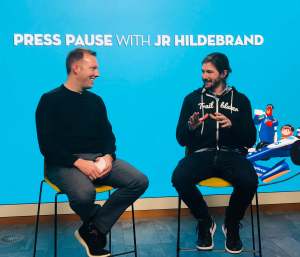J.R. Hildebrand, who will drive the Salesforce-sponsored car 66 in this month’s Indianapolis 500 race, concedes that compared to some other professional race car drivers he may be “a little more cerebral.” The 30-year-old Sausalito native got into both M.I.T. and U.C. Berkeley, but chose racing as his true calling. He tweets his reading list, and instructs students on autonomous car technology at Stanford University. In high school, he had an epiphany when he realized calculus can be applied to racing.
J.R. stopped by Salesforce’s San Francisco headquarters to speak with employees. We caught up with him for an interview on racing, technology, racing movies, and what it feels like for him to join the Salesforce Ohana.
What first attracted you to racing as a kid?
It was really just the speed. I was always into cars. I enjoyed motorsports. But the first time I got in a go cart, it was just sensory overload. And that was an experience I had never felt doing anything else. I’d raced BMX bikes, and it was always kind of in my blood a little bit, I think. But once I actually got in a go cart–you’re sort of taming the beast. It’s a very primal set of feelings.
You were a bookish guy starting at a young age, a National Merit Scholar accepted by top universities. What drove your decision to go pro as a driver?
For me it wasn’t that hard. It was very clear the last couple of years of high school that if I was going to pursue it,I was going to have to pursue it at a highly committed level. And, unlike playing basketball, baseball, or football, it doesn’t align with school activities. It’s not an after-school activity. It’s during school on a lot of days, and you’re traveling a lot.
So I experienced that enough, just in high school, to recognize that I kind of needed to choose a direction. Even if maybe I could get through another year or two of doing more than one thing, that wasn’t going to be the long game.
Becoming a professional race car driver is a very obscure job to end up with. I meet with students and I tell them that the things that they are studying in school are highly relevant to really interesting things going on out in the world. That’s just as true for racing cars as going to Mars or studying medicine.
If you look forward at the next decade of transportation, what do you see as the challenges and opportunities?
There’s obviously already a huge influx of technology permeating everything about our mobility system at large, from the actual vehicles and products on the road to the way that we interact with those vehicles and products. For me, the main takeaway is that we have to come up with solutions that fit the system of parts – not solutions that are specifically designed for one linear growth path.
So when we think about autonomous vehicles, I’m very much of the opinion that regardless of whether there’s the intention, or the desire, for there to be human drivers in vehicles interacting with autonomous vehicles, we should be designing autonomous vehicles to be able to withstand human drivers as a part of their environment.
You said you like the vibe of the Salesforce Ohana. If you were not driving an Indy car, could you see yourself as a Salesforce engineer, if you had gone to M.I.T. or Berkeley?
Yeah! Working with other partners within motorsports you see a lot of different types of cultures and philosophies. You see the way people operate, and the way companies operate. I think it’s so important to be somewhere where you can get the most out of your own skill set. Salesforce certainly stands out as a place that understands and sort of embraces that.
What are your top three racing movies?
Top three racing movies. Let’s see… “Le Mans” with Steve McQueen is an excellent one. “Grand Prix” with James Garner, from back in the day, is great. And I’d be lying to you if I didn’t say that I love “Days of Thunder” (laughs).
You tweeted your reading list the other day. You’re not just plugging into tech. You’re also reading George Orwell, and All the President’s Men. Have you always been an avid reader?
I probably – good, bad, or otherwise – come off as a little more cerebral than some. I wasn’t a big reader as a kid. Some of these books, like “1984,” I was probably supposed to read in high school and I just read the CliffsNotes instead. But as an adult, I’ve had some great books that have kind of pulled me through. I’ve been able to sit down and have some good reads that have helped me get through situations. So I’ve embraced other people’s reading lists, and I enjoy going back and catching up on things that I should have read a long time ago.
What about music? What will be on your playlist for race day?
I was born in the late ’80s, and my music tastes live in the ’90s. I was a huge Rage Against the Machine fan. Definitely West Coast hip-hop from the late ’90s and early 2000s. Tupac, Too Short, E-40, that’s definitely been my jam from high school on. But I like a lot of the new alternative rock, like the Black Keys.
Who was your favorite driver growing up?
It sounds funny to people because I always raced open-wheel cars, but Dale Earnhardt Senior was my racing idol. Even guys like that, who seem really rough and raw, there’s a philosophy, kind of a mindset, behind all of that.
What are some of the biggest misconceptions about racing?
Among the most significant misconceptions is that racing proficiency is just one reactive, kind of instinctual thing. When you think of (Ayrton) Senna, Michael Schumacher, and Dale Earnhardt, those three guys, in terms of their mental attitude, could not be more different from each other. Senna’s just ultra-intense and passionate. Schumacher was ultra-mathematical and like a professor, almost, in terms of how he approached every little detail. Earnhardt was “The Intimidator,” right? It’s an attitude thing. But each of those different mindsets was really developed over a long period of time. And they extracted their greatness out of being so focused in their own ways. They were great in different areas, embracing their own mental attitudes.
On the technology scene right now, what really inspires you?
That’s a great question. I think for me, it’s maybe less about some specific area of technology and more about asking in what ways are we extracting great human experiences out of our technologies? There seems to be a trend where there is advancement of technology just for the sake of it. People think that things are getting better, and advancing at this exponential rate, just because the snowball is rolling downhill.
I think there’s a question that needs to be asked about all technologies, which is "Are these things really making our lives better?" I’ve become really attached to the things that inspire me, that make for intense human experiences. I want to live in a future, driven by technology, that has more of those experiences.
The Indianapolis 500 revs up May 27. Follow J.R. Hildebrand on Twitter as he prepares for the race.
















